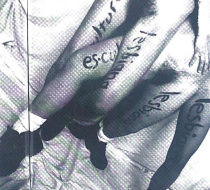Es-Cultura Lesbiana Favorite
As a result of the social stigma of homosexuality, lesbian feminists were rejected and silenced as a radical minority within the mainstream Movimiento Feminista (MF). Lesbianas Sin Duda (LSD) is a queer activist group based in Madrid that arose in the early 1990s as a response to this erasure. In order to combat the invisibility of lesbians within the broader feminist movement, LSD began publishing a series of fanzines aptly called Non-Grata (Snyder, 2020, p. 321). Within the pages of the June 1995 edition of Non-Grata is a photography exhibition entitled Es-Cultura Lesbiana that displays “el cuerpo lesbiano,” or the lesbian body (LSD, 1995, p. 10). Each set of legs is painted with the phrase, “es-cultura lesbiana.” The phrase contains a clever double meaning, as it can be understood to mean either “lesbian sculpture,” or “it’s lesbian culture.”
LSD’s explicit depiction of the lesbian body departs from previous representations of lesbianism because it openly embraces the obscene, “militant sexualization” of the female body (Snyder, 2020, p. 322). By daringly depicting the lesbian body as erotic and embracing the socially unacceptable, LSD challenges norms within the mainstream feminist movement. This enables them to fight against conformity and assimilation as a final goal of the LGBT+ movement and instead carves out a space for a distinctly queer culture and mode of existence that is not bound by the rules imposed by the heteropatriarchy.
The overtly sexual photographs also serve to celebrate the lesbian body, which exists on the margins of the LGBT+ community. Since the LSD photo series contained within the 1995 issue of Non-Grata was completely created by lesbians in the collective, it enabled them to depict lesbian sexuality in a manner that accurately portrayed their lived experiences. The photos in the Es-Cultura Lesbiana series function as a medium to share the lived experiences of lesbianism, but also as a mode of resistance by bringing together the LSD collective to organize around advancing the cause of queer liberation.
As Fefa Vila, queer activist and member of LSD explains in an interview with Gracia Trujillo and Marcelo Expósito, the Es-Cultura Lesbiana photo series was received with significant controversy throughout the Lavapiés neighborhood, Spain, and the broader world. The controversial nature of the photograph series gave it power—by stirring up controversy, it succeeded in making lesbian sexuality visible. As Vila explains, this prompted widespread, transformative discourse about the lesbian body, which was precisely the LSD collective’s goal: “eran nuestros cuerpos los que queríamos marcar de forma diferente, para que se hacieran visibles y, en la medida en que se hiciesen visibles, puediesen nombrar y alterar realidades directamente” [it was our bodies that we wanted to mark in a different way, so that they would become visible, and to the extent that they became visible, they could name and answer realities directly] (Vila, qtd. in Trujillo and Expósito, 2004, p. 16).
Photo: Housed in the Queer Archives at the Museo Reina Sofía Library and Documentation Centre






